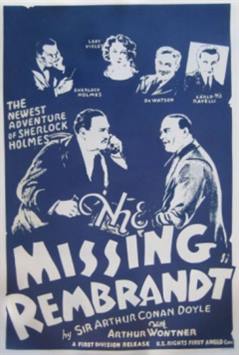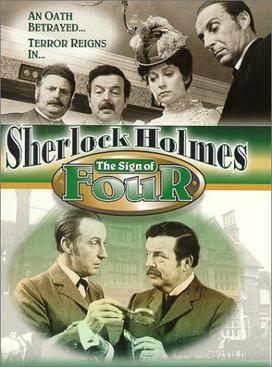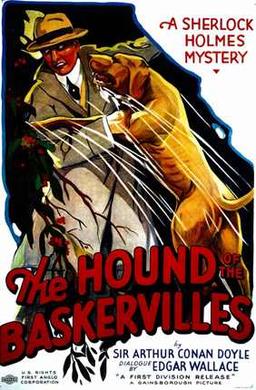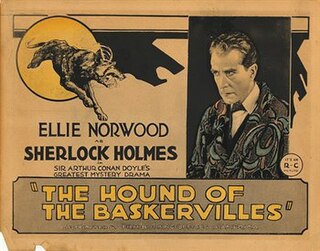
"The Adventure of Silver Blaze", one of the 56 Sherlock Holmes short stories written by Sir Arthur Conan Doyle, is the first from the 12 in the cycle collected as The Memoirs of Sherlock Holmes. It was first published in The Strand Magazine in December 1892.

Colonel Sebastian Moran is a fictional character in the stories written by Arthur Conan Doyle. An enemy of Sherlock Holmes, he first appears in the 1903 short story "The Adventure of the Empty House". Holmes once described him as "the second most dangerous man in London", the most dangerous being Professor Moriarty, Moran's employer.
The stories of Sherlock Holmes by Sir Arthur Conan Doyle have been very popular as adaptations for the stage, and later film, and still later television. The four volumes of the Universal Sherlock Holmes (1995) compiled by Ronald B. De Waal lists over 25,000 Holmes-related productions and products. They include the original writings, "together with the translations of these tales into sixty-three languages, plus Braille and shorthand, the writings about the Writings or higher criticism, writings about Sherlockians and their societies, memorials and memorabilia, games, puzzles and quizzes, phonograph records, audio and video tapes, compact discs, laser discs, ballets, films, musicals, operettas, oratorios, plays, radio and television programs, parodies and pastiches, children's books, cartoons, comics, and a multitude of other items — from advertisements to wine — that have accumulated throughout the world on the two most famous characters in literature."
Sherlock Holmes has long been a popular character for pastiche, Holmes-related work by authors and creators other than Arthur Conan Doyle. Their works can be grouped into four broad categories:

The Hound of the Baskervilles is a 1939 American gothic mystery film based on the 1902 Sherlock Holmes novel of the same name by Sir Arthur Conan Doyle. Directed by Sidney Lanfield, the film stars Basil Rathbone as Sherlock Holmes and Nigel Bruce as Dr. John Watson. Released by 20th Century Fox, it is the first of fourteen Sherlock Holmes films produced between 1939 and 1946 starring Rathbone and Bruce.

Arthur Wontner was a British actor best known for playing Sir Arthur Conan Doyle's master detective Sherlock Holmes in five films from 1931 to 1937.

The Adventures of Sherlock Holmes is a 1939 American mystery adventure film based on Sir Arthur Conan Doyle's Sherlock Holmes detective stories. Although claiming to be an adaptation of the 1899 play Sherlock Holmes by William Gillette, the film bears little resemblance to the play.
Mrs. Hudson is a fictional character in the Sherlock Holmes novels and short stories by Arthur Conan Doyle. She is the landlady of 221B Baker Street, the London residence in which Sherlock Holmes lives.

Ian Fleming was an Australian character actor with credits in over 100 British films. One of his best known roles was playing Dr Watson in a series of Sherlock Holmes films of the 1930s opposite Arthur Wontner's Holmes.

The Sleeping Cardinal, also known as Sherlock Holmes' Fatal Hour in the United States, is a 1931 British mystery film directed by Leslie S. Hiscott and starring Arthur Wontner and Ian Fleming. The film is an adaptation of the Sherlock Holmes stories by Arthur Conan Doyle. Although it is not based on any one particular story, the film draws inspiration from "The Empty House" and "The Final Problem". The film is the first in the 1931–1937 film series starring Wontner as Sherlock Holmes. It is unrelated to the Basil Rathbone series of Sherlock Holmes films that began in the late 1930s.

The Sign of Four is a 1932 British crime film directed by Graham Cutts and starring Arthur Wontner, Ian Hunter and Graham Soutten. The film is based on Arthur Conan Doyle's second Sherlock Holmes novel The Sign of the Four (1890). The film is also known as The Sign of Four: Sherlock Holmes' Greatest Case.

The Triumph of Sherlock Holmes is a 1935 British mystery film directed by Leslie S. Hiscott and starring Arthur Wontner. It was based on the 1915 Sherlock Holmes novel The Valley of Fear by Arthur Conan Doyle.

The Speckled Band is a 1931 British mystery film directed by Jack Raymond and starring Lyn Harding, Raymond Massey and Angela Baddeley. It is an adaptation of Arthur Conan Doyle's original 1892 story "The Adventure of the Speckled Band" and the 1910 play he adapted from it, The Speckled Band.

The Missing Rembrandt is a 1932 British mystery film directed by Leslie S. Hiscott and starring Arthur Wontner, Jane Welsh, Miles Mander, and Francis L. Sullivan. It is considered a lost film. The film was loosely based on the 1904 Sherlock Holmes story "The Adventure of Charles Augustus Milverton" by Arthur Conan Doyle.

The Sign of Four is a 1983 British made-for-television mystery film directed by Desmond Davis and starring Ian Richardson and David Healy. The film is based on Sir Arthur Conan Doyle's 1890 novel of the same name, the second novel to feature Sherlock Holmes and Doctor Watson.
Sherlock Holmes is a film series running from 1931 to 1937. Arthur Wontner portrayed Sherlock Holmes in five films.

The Hound of the Baskervilles is a 1932 British mystery film directed by Gareth Gundrey and starring John Stuart, Robert Rendel and Frederick Lloyd. It is based on the 1902 novel The Hound of the Baskervilles by Arthur Conan Doyle, in which Sherlock Holmes is called in to investigate a suspicious death on Dartmoor. It was made by Gainsborough Pictures. The screenplay was written by Edgar Wallace.

The Hound of the Baskervilles is a 1921 British silent mystery film directed by Maurice Elvey and starring Eille Norwood, Catina Campbell and Rex McDougall. It is based on the 1902 Sherlock Holmes novel The Hound of the Baskervilles by Arthur Conan Doyle. It was made by Stoll Pictures, Britain's largest film company at the time. It was the first British film adaptation of the famous novel.
Sherlock Holmes is the overall title given to the series of radio dramas adapted from Arthur Conan Doyle's Sherlock Holmes stories that aired between 1952 and 1969 on BBC radio stations. The episodes starred Carleton Hobbs as Sherlock Holmes and Norman Shelley as Dr. Watson. All but four of Doyle's sixty Sherlock Holmes stories were adapted with Hobbs and Shelley in the leading roles, and some of the stories were adapted more than once with different supporting actors.














